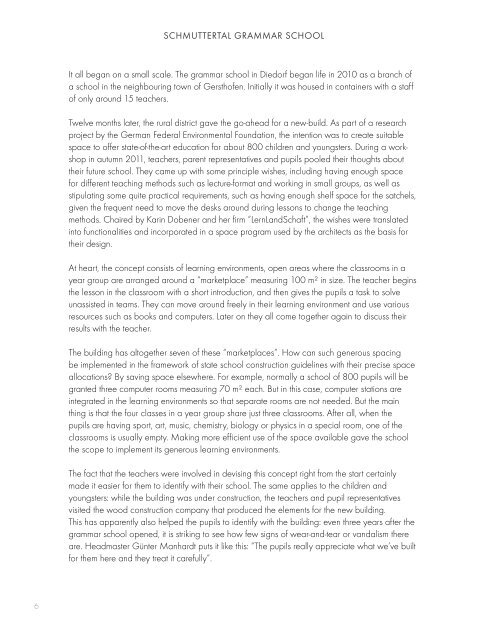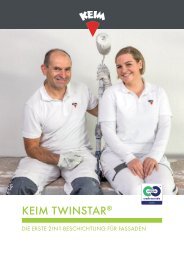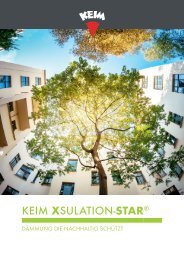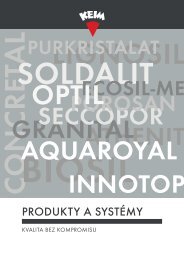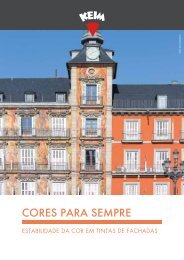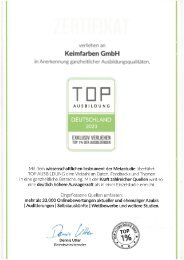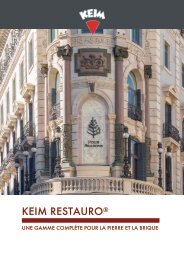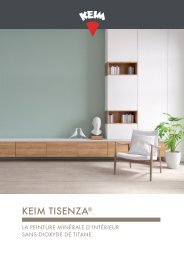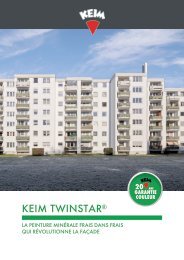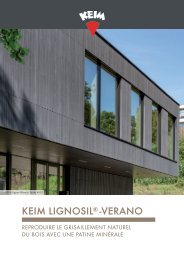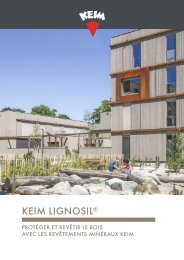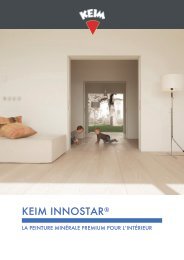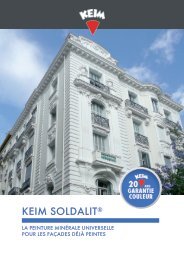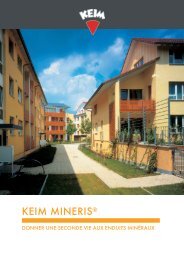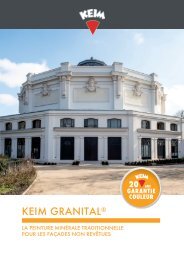KEIM Edition No. 2: Schmuttertal Grammar School
Create successful ePaper yourself
Turn your PDF publications into a flip-book with our unique Google optimized e-Paper software.
SCHMUTTERTAL GRAMMAR SCHOOL<br />
It all began on a small scale. The grammar school in Diedorf began life in 2010 as a branch of<br />
a school in the neighbouring town of Gersthofen. Initially it was housed in containers with a staff<br />
of only around 15 teachers.<br />
Twelve months later, the rural district gave the go-ahead for a new-build. As part of a research<br />
project by the German Federal Environmental Foundation, the intention was to create suitable<br />
space to offer state-of-the-art education for about 800 children and youngsters. During a workshop<br />
in autumn 2011, teachers, parent representatives and pupils pooled their thoughts about<br />
their future school. They came up with some principle wishes, including having enough space<br />
for different teaching methods such as lecture-format and working in small groups, as well as<br />
stipulating some quite practical requirements, such as having enough shelf space for the satchels,<br />
given the frequent need to move the desks around during lessons to change the teaching<br />
methods. Chaired by Karin Dobener and her firm “LernLandSchaft”, the wishes were translated<br />
into functionalities and incorporated in a space program used by the architects as the basis for<br />
their design.<br />
At heart, the concept consists of learning environments, open areas where the classrooms in a<br />
year group are arranged around a “marketplace” measuring 100 m² in size. The teacher begins<br />
the lesson in the classroom with a short introduction, and then gives the pupils a task to solve<br />
unassisted in teams. They can move around freely in their learning environment and use various<br />
resources such as books and computers. Later on they all come together again to discuss their<br />
results with the teacher.<br />
The building has altogether seven of these “marketplaces”. How can such generous spacing<br />
be implemented in the framework of state school construction guidelines with their precise space<br />
allocations? By saving space elsewhere. For example, normally a school of 800 pupils will be<br />
granted three computer rooms measuring 70 m² each. But in this case, computer stations are<br />
integrated in the learning environments so that separate rooms are not needed. But the main<br />
thing is that the four classes in a year group share just three classrooms. After all, when the<br />
pupils are having sport, art, music, chemistry, biology or physics in a special room, one of the<br />
classrooms is usually empty. Making more efficient use of the space available gave the school<br />
the scope to implement its generous learning environments.<br />
The fact that the teachers were involved in devising this concept right from the start certainly<br />
made it easier for them to identify with their school. The same applies to the children and<br />
youngsters: while the building was under construction, the teachers and pupil representatives<br />
visited the wood construction company that produced the elements for the new building.<br />
This has apparently also helped the pupils to identify with the building: even three years after the<br />
grammar school opened, it is striking to see how few signs of wear-and-tear or vandalism there<br />
are. Headmaster Günter Manhardt puts it like this: “The pupils really appreciate what we’ve built<br />
for them here and they treat it carefully”.<br />
6


